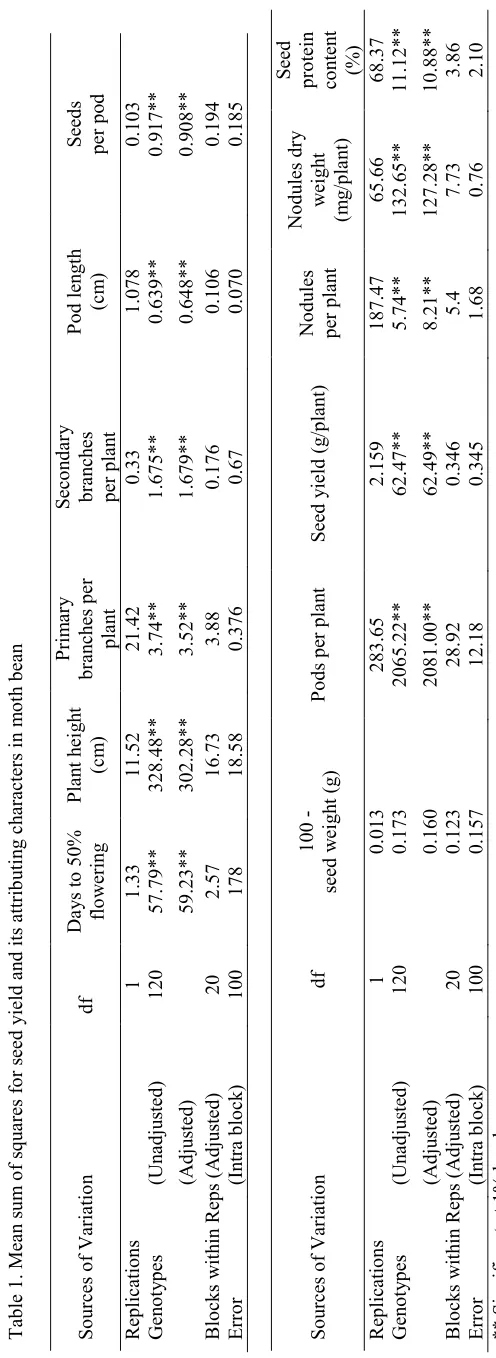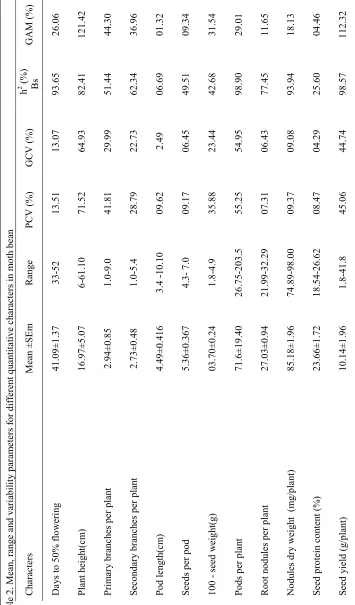Electronic Journal of Plant Breeding, 3(1):671-675 (Mar 2012) ISSN 0975-928X
http://sites.google.com/site/ejplantbreeding 671
Research Note
Genetic variability studies in Moth bean germplasm for seed yield and its
attributing characters
Yogeesh L.N1, Viswanatha K.P2, Ravi B.A3and Gangaprasad S4*. 1
Agricultural Research Station, UAS, Raichur, Hagai-583138, Bellary District, Karnataka 2 AICRP on Chickpea, GKVK Farm, UAS, Bangalore-560 065, Karnataka.
3
Department of Biology, Plant Biotechnology, ETH Zurich, Universitaetstrasse 2, 8092 Zurich, Switzerland 4
Département of Genetics and Plant Breeding, College of Agriculture, Shimoga, UAS, Bangalore, Karnataka Email : gangaprasad08@gmail.com
(Received: 09 Oct 2011; Accepted: 06 Mar 2012)
Abstract:
Moth bean is a drought tolerant pulse crop grown in arid and semiarid regions of India. Genetic variability for yield and its component characters was studied in moth bean germplasm collected from different geographical regions of India. Analysis of variance showed the presence of significant variability among the genotypes studied and for all the traits excluding 100 seed weight. The estimates of PCV and GCV were high for plant height, primary branches per plant, secondary branches per plant, 100 seed weight, pods per plant and seed yield per plant. High heritability and Genetic Advance was observed for days to 50 per cent flowering, plant height, secondary branches per plant, pod length, pods per plant and seed yield characters studied offering scope for improvement of these traits through simple selection.
Keywords: Moth bean, genetic variability, heritability
Moth bean [Vigna radiata (L) Wilczek] is an
important arid pulse crop of India. It is principally grown for its protein rich edible seeds, dry seeds and sprouts. It is an excellent source of easily digestible protein with low flatulence and is consumed as dhal, bean sprouts, noodles, green beans and boiled dry beans. It is a short duration legume, grown in all the
three seasons viz., kharif, rabi, summer. Moth bean is
grown in India over an area of 13.53 lakh hectares with an annual production of 2.91 lakh tonnes and productivity of 215 kg per hectare (Anon., 2008). In Karnataka cultivation of moth bean is least amongst other growing states in India and mainly grown in Northern districts of Karnataka. Besides low productivity, moth bean is also known for plant types of primitive nature, conferring its evolution for survival but not for grain productivity. The low productivity is attributed to susceptibility of moth bean to biotic and abiotic stresses. Besides low productivity, moth bean is also known for plant types of primitive nature, conferring its evolution for survival but not for grain productivity. Information on genetic variability parameters like phenotypic co-efficient of variation (PCV), genotypic co-co-efficient of variation (GCV), Heritability and genetic advance is of great importance to the breeder which helps planning crop improvement programmes. This present study was undertaken to study genetic
variability among moth bean accessions and to identify superior genotypes for yield and its components under Bangalore conditions.
The experimental material comprised of 121 moth bean genotypes collected from different parts of North Karnataka, Maharashtra and CZRI, Rajasthan under Adhoc project on moth bean funded by Kirkhouse Trust, United Kingdom at Gandhi Krishi Vigynaa Kendra, Bangalore. The entries were sown in a single row of three meter length with spacing of 30 cm between rows and 10 cm between plants. The experiment was laid out in Simple Lattice Design
with two replications during Kharif 2010-11 at Zonal
Agricultural Research Station, Bangalore. The crop was raised as per the recommended package of practices and better crop growth was achieved. At the time of maturity five plants selected at random from each genotype were tagged in each replication and observations on quantitative traits were recorded. The mean values on these observations were subjected for statistical analysis to compute analysis of variance [Cochran and Cox (1957)], PCV and GCV (Burton and De Vane, 1953; Sivasubramanian and Menon, 1979), Heritability in broad sense for all the characters (Lush, 1946) and Robinson (1949) and
genetic advance for each character (Johnson et al.,
Electronic Journal of Plant Breeding, 3(1):671-675 (Mar 2012) ISSN 0975-928X
http://sites.google.com/site/ejplantbreeding 672
Analysis of variance (Table 1) revealed that the genotypes exhibited significant differences for all the traits studied except 100 seed weight indicating the presence of genetic variability and the choice of the material for the investigation is appropriate. One of the ways to appreciate the extent of variability is to examine the range, which reflects the extent of phenotypic variability in respect of the trait under
consideration, encompassing genotypic,
environmental and interaction components. In the present study, the moth bean genotypes exhibited
wide range values for all characters viz., days to 50
per cent flowering, plant height, primary branches per plant, secondary branches per plant, pod length, pods
per plant, seeds per pod, 100- seed weight, root
nodules per plant, nodules dry weight, seed protein content and seed yield per plant High range values indicate good scope for selection for any trait of interest for the breeder to exercise his selection. The difference between GCV and PCV values was more for plant height, primary branches per plant and 100- seed weight indicating that selection based on phenotypic observations may not be very effective for these traits (Table 2). In general, the PCV and GCV were quite high for plant height, primary branches per plant, secondary branches per plant, 100- seed weight, pods per plant and seed yield per plant indicating that there is greater scope for selection for improvement of these characters. These
findings are in confirmation with Byregowda et al.,
(1997), Khainar et al. (2003), Lakshmi Narayana
Reddy et al. (2003b), Nasser Ahmed and Lavanya
(2005), Ritu et al., (2005) and Mallikarjuna Rao et al.
(2006) in mungbean. Contrary to the above the traits namely days to 50 per cent flowering and pod length showed moderate values of PCV and GCV while for
the remaining characters viz., seeds per pod, root
nodules per plant, nodules dry weight and seed protein content, PCV and GCV values were low. Similar results have been reported by Mallikarjuna Rao et al. (2006) in mungbean.
High heritability coupled with high genetic advance reveals the presence of lesser environmental influence and prevalence of additive gene actions in their expression (Panse, 1957). But lower values of genetic advance indicate the prevalence of narrow range of variability, high G x E interaction or non-additive gene action. For moderate values of genetic advance, both additive and non-additive gene actions might be responsible for the expression of traits. High heritability coupled with high genetic advance as per cent of mean was observed for days to 50 per cent flowering, plant height, secondary branches per plant, pods per plant and seed yield suggesting that these
characters are under the control of additive genes and phenotypic selection for these characters may be effective. These results are in agreement with the
results obtained in mungbean by Byregowda et al.
(1997) and Mallikarjuna Rao et al. (2006). High
heritability and moderate genetic advance were observed for the characters root nodules per plant and nodules dry weight. This moderate value may be due to moderate values for phenotypic standard deviation as the heritability is high for these characters . However, there is no literature available for the traits either in moth bean or any other related pulses in support of the result obtained. Moderate heritability associated with high genetic advance were observed for 100- seed weight and primary branches per plant indicating the prevalence of additive gene action and high value for phenotypic standard deviation, as the heritability was moderate. Moderate heritability coupled with low genetic advance was observed for seeds per pod. Whereas, seed protein content showed low heritability and low genetic advance indicating considerable influence of environment apart from non-additive gene action. Therefore, simple selection may not be effective in improvement of these traits. Moth bean is a neglected and minor pulse crop of Karnataka but nutritionally rich. There is no systematic breeding work done so for in moth bean and the present investigation is the first step to reveal that there is a considerable amount of genetic variation present in the moth bean germplasm. These accessions will be used as base material for further moth bean improvement programme in Karnataka. Acknowledgement: The authors are very grateful to the Kirkhouse Trust, UK for supporting the project and Dr. Southern and Dr. Robert Koebner, KHT, UK for providing technical support.
References
Anonymous. 2008. Directorate of economics and statistics, New Delhi. NHDF, Rajasthan. Burton, G.W. and De Vane, G.M. 1953. Estimating
heritability in tall Fescue (Festuca arundinaceae)
from replicated clonal material. Agron. J., 45: 478-481.
Byregowda, M., Chandraprakash, J., Jagadish Babu, C.S. and Rudraswamy P. 1997. Genetic variability and interrelationships among yield and yield components in greengram. (Vigna radiata L. Wilczek).CropRes. Hisar, 13: 361-368.
Cochran, W.G. and Cox, G.M. 1957. Experimental Designs. John Wiley and Sons, Inc., 611pp. New York.
Electronic Journal of Plant Breeding, 3(1):671-675 (Mar 2012) ISSN 0975-928X
http://sites.google.com/site/ejplantbreeding 673
Khairnar, M.N., Patil, J.V., Deshmukh, R.B. and Kute, N.S. 2003. Genetic variability in mungbean. Legume Res., 26: 69-70.
Lakshmi Narayana Reddy, V., Reddisekhar, Raja Reddy, K. and Hariprasad Reddy, K. 2003. Genetic variability for yield and its components in mungbean [Vigna radiata (L.) Wilczek].
Legume Res., 26: 300-302.
Lush, J.L. 1945.Heritability of quantitative characters in farm animals. Proc. 8th Cong. Heriditas, 35: 356-375.
Mallikarjuna Rao, C., Koteswara Rao, Y. and Mohan Reddy. 2006. Genetic variability and path analysis in mungbean. Legume Res., 29: 216-218. Naseer Ahmed and Lavanya, G.R. 2005. Genetic variability studies in genotypes of mungbean [Vigna radiata (L.) Wilczek]. The Andhra Agric. J., 52: 577-579. Panse, V.G. 1957. Genetics of quantitative characters in relation to plant breeding. Indian J. Genet., 17: 318-328.
Ritu, R., Saxena, P.K., Singh and Ravi, R. S. 2005. Multivariate analysis in mungbean. Indian J. Pulses Res., 18: 26-27.
Robinson, H.F., Comstock, R.E. and Harvey, P.H. 1949. Estimates of heritability and degree of dominance in corn. Agron. J,. 41: 353-359. Sivasubramanian, S, S. and Menon, M.1979. Heterosis and
E le ct ro n ic J o u rn al o f P la n t B re ed in g , 3 (1 ): 6 7 1 -6 7 5 ( M ar 2 0 1 2 ) IS S N 0 9 7 5 -9 2 8 X h tt p :/ /s it es .g o o g le .c o m /s it e/ ej p la n tb re ed in g 6 7 5 T ab le 2 . M ea n , ra n g e an d v ar ia b il it y p ar a m et er s fo r d if fe re n t q u an ti ta ti v e c h ar ac te rs i n m o th b ea n C h ar ac te rs M ea n ± S E m R an g e P C V ( % ) G C V ( % ) h
2 (

